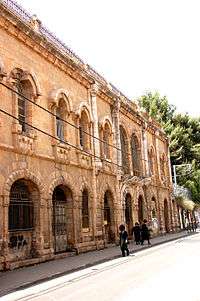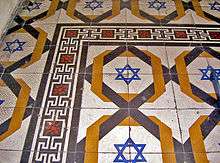Bukharim Quarter
The Bukharan Quarter (Hebrew: שכונת הבוכרים, Shkhunat HaBukharim), known in vernacular Heblish as Bukharim Quarter, is a neighborhood in the center of Jerusalem. Many of the residents today are Haredi Jews. The quarter borders Tel Arza on the west, the Shmuel HaNavi neighborhood on the north, Arzei HaBira on the east and Geula on the south.

History
The first immigrants of Bukharan Jews from Russian Turkestan (Central Asia) settled in Jerusalem in the 1870s and 1880s.[1] They bought land and employed architect Conrad Schick to design a neighborhood for them. In 1890, seven members of the Bukharan Jewish community formed the Hovevei Zion Association of the Jewish communities of Bukhara, Samarkand and Tashkent. In 1891, the association drew up a charter stating that the new quarter would be built in the style of Europe's major cities. The streets were three times wider than other streets in Jerusalem at the time, and spacious mansions were built with large courtyards. The homes were designed with neo-Gothic windows, European tiled roofs, neo-Moorish arches and Italian marble. Facades were decorated with Jewish motifs such as the Star of David and Hebrew inscriptions.[1]
In 1905-1908, a dairy was opened and cotton fields were planted on the outskirts of the neighborhood.[2] Construction of the quarter continued into the early 1950s. A total of 200 houses were built. During World War I, the Turkish army occupied several buildings and cut down almost all of the trees.[1]
In 1920, a factory for weaving Persian carpets opened, providing employment for 80 women.[2]
Landmarks
Yehudayoff Palace ("Armon")

Between 1905–1914 Bukharan merchant Elisha Yehudayoff and his son-in-law, Yisrael Haim Hefetz, built the Armon (lit. "palace") using local limestone and Italian marble with Italian-baroque ornaments. The "Armon" hosted many of the leading figures of the time. During World War I, the Turkish army had its headquarters there. When the British captured Jerusalem in 1917, a celebratory reception was held in the "Armon". 200 Jewish soldiers serving in the British army attended a Passover Seder there. In 1921, the founding convention of the Chief Rabbinate took place at the "Armon", at which Rabbis Abraham Isaac Kook and Jacob Meir were elected. At the end of the British Mandate the "Armon" served as a meeting place for the Irgun.[2]
Davidoff House
The Davidoff House, built in 1906, now serves as the community center.
Notable residents
See also
| Wikimedia Commons has media related to Bukharim neighborhood. |
References
- Eylon, Lili (2011). "Jerusalem: Architecture in the late Ottoman Period". Jewish Virtual Library. Retrieved 28 August 2011.
- Bukharan community
